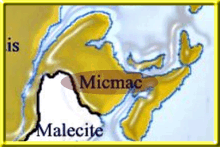CANADA HISTORY
Chipewyan

The Chipewyan people, also known as the Dene, are an Indigenous group that has lived in the boreal forests and tundra of northern Canada for thousands of years. They have a rich and complex history and culture, and have been known for their exceptional hunting, fishing, and trapping skills, as well as their knowledge of the land and its resources.
The Chipewyan have a strong oral tradition, and their stories, songs, and legends have been passed down from generation to generation. These stories provide important information about their beliefs, values, and history, and are an integral part of their cultural heritage.
The Chipewyan were traditionally semi-nomadic, moving from place to place in search of food and resources. They were known for their knowledge of the land and its resources, and their ability to adapt to their environment. They were also known for their skill in hunting large game, such as caribou and moose, as well as fishing and trapping smaller animals.
In the 19th and 20th centuries, the Chipewyan faced numerous challenges, including the arrival of European settlers, who brought diseases and disrupted their traditional way of life. The Chipewyan also faced pressure from the Canadian government to give up their land and move onto reservations. Despite these challenges, the Chipewyan have maintained their cultural identity and traditions, and continue to play a vital role in the preservation of their heritage and history.
Today, the Chipewyan are recognized as one of the Indigenous peoples of Canada, and are working to reclaim their land, rights, and cultural heritage. They continue to play a vital role in the preservation of their culture, and are actively involved in initiatives to pass on their knowledge, stories, and traditions to future generations.
Trade with Europeans had some benefits for the Chipewyan people. European fur traders brought with them new technologies, such as guns and traps, which improved the Chipewyan's hunting and trapping abilities. The trade in furs also provided the Chipewyan with new goods and materials, such as textiles and metal tools, which they had not had access to before.
Overall, the trade relationship between the Chipewyan and Europeans was complex and had both positive and negative impacts. While the Chipewyan did benefit from some aspects of the trade relationship, the long-term impacts were often negative and had a profound impact on their communities and way of life.
Here are some significant events and dates in the history of the Chipewyan people:
Pre-contact period: The Chipewyan have lived in northern Canada for thousands of years, long before the arrival of European settlers. During this time, they developed a complex culture and way of life based on their relationship with the land and its resources.
Early European contact: European fur traders and explorers began to make contact with the Chipewyan in the late 17th and early 18th centuries. This contact had a significant impact on the Chipewyan, introducing new diseases and disrupting their traditional way of life.
Treaty-making period: In the late 19th and early 20th centuries, the Canadian government signed treaties with Indigenous peoples across the country, including the Chipewyan. These treaties, known as Treaty 8, were meant to ensure that Indigenous peoples would be able to continue to occupy their traditional lands and maintain their way of life.
Residential schools: In the late 19th and early 20th centuries, the Canadian government established residential schools for Indigenous children. These schools were designed to assimilate Indigenous children into Canadian society, and many children were taken from their families and forced to attend these schools. This period had a profound and lasting impact on Indigenous communities, including the Chipewyan.
Modern era: In the late 20th and early 21st centuries, the Chipewyan, along with other Indigenous peoples across Canada, have been working to reclaim their land, rights, and cultural heritage. This has included initiatives to revive traditional practices and pass on cultural knowledge to future generations.

Cite Article : www.canadahistory.com/sections/documents




